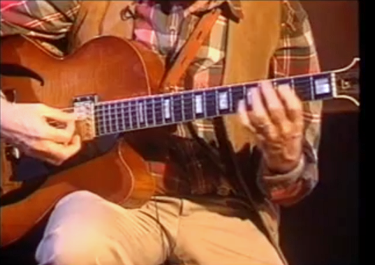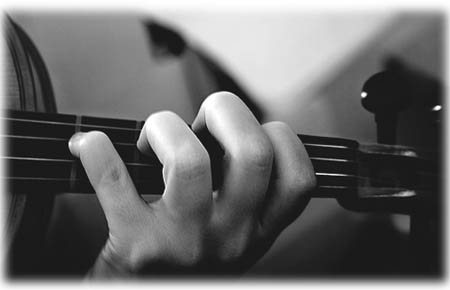« November 2013 |
Main
| January 2014 »
 December 26, 2013 | Best of JM: Building a Solo
December 26, 2013 | Best of JM: Building a Solo
Enjoy the popular archive material below.
From February 23, 2012 | Building a Solo
 In improvisation, there's always a question of how much creativity is framed in intention and how much in brash, unbridled spontaneity. It's the enigma of the whole generating process, how much do we contrive out of calculation (modes, arpeggios, regenerated riffs) and how much just comes out of nowhere. We maintain you have to have a balance of both. Blind directionless blowing goes nowhere and has no repeatable structure for the listener to grasp. Mechanical, scale quotes are dispassionate and soulless. You need the combination. In improvisation, there's always a question of how much creativity is framed in intention and how much in brash, unbridled spontaneity. It's the enigma of the whole generating process, how much do we contrive out of calculation (modes, arpeggios, regenerated riffs) and how much just comes out of nowhere. We maintain you have to have a balance of both. Blind directionless blowing goes nowhere and has no repeatable structure for the listener to grasp. Mechanical, scale quotes are dispassionate and soulless. You need the combination.
One area you should aim for improvement is the concept of story-telling. The set-up, the conflict, the resolution. The story arc of any good movie, novel, or TV show should be as conscious of form as it is internal detail. Good soloists wrap their stories within the context of character development and intent.
The End. We mention this first, because it's the most often ignored. You finish your solo, and there's question whether or not you're really done. A good soloist hands the baton to the next soloist (or returns to the head) and gives a sense of finality. Good authors don't just arbitrarily write their words, they have a sense of how the story is going to end, and that should be the same with improvisation. You can end in a multitude of ways, a gripping climax of high notes, or a resolving release of tension in the lower register. Whatever your choice, you need to communicate a sense of "I've said what I'm going to say."
Intermediate resonance. In the middle of it all, you need to convey a sense of familiarity midst the departure. Returning to motifs from the melody or repeating nuggets from the previous soloists are a way of maintaining a sense of whole. You want to explore, but bring it home a few times with something the audience has already heard. The contrast makes the journey away even more intriguing.
Minor arcs of conflict and resolution. "Call and response" is like the soloist having a conversation with himself. Also called "antecedent/consequence," the technique is to include minor phrases of question, answer, question, answer. It can be as short as a couple notes or as long as four measure phrases. If you don't consciously include these in your solos, you'll sound meandering and directionless.
The Beginning. How you start the solo is almost as important as how you end. As the saying goes, "you never have another chance to make a first impression." You want to start with something concrete and intentional, but without the sophomore mistake of unloading all your best material in the first five measures. It can be transitional in nature, repeating the last phrase of the last soloist to set up a continuing story. It can be bold and contrasting, a new story. It should always be something you can build off of, confident and catchy.
We focus a lot on the details of soloing, borrowing notes from the scale, outlining harmonic progression, propelling with gravity notes and exploiting guide tones, but just as important is form. The best solos will be properly framed and hung proudly on the wall, worthy of display.
Further:
Compose yourself. Story Arcs
Compose yourself. Antecedent/Consequent thinking
Don Stiernberg on the "Big Picture" of improvising
Intentional Improvisation
More Appropriate
Posted by Ted at 6:14 AM
 December 19, 2013 | Pete Martin Tips: The Number System in Music Theory
December 19, 2013 | Pete Martin Tips: The Number System in Music Theory

You may have been taught Solfege in school. It's a complex approach of names and hand signals for learning scales and intervals and most helpful in understanding pitch relationships. There is a simpler approach that just uses numbers. It's one that might be of use to you, and it's explained visually on a great video from Pete Martin's video channel.
Video Link: The Number System in Music Theory
Read our Mandolin Cafe interview from last year: The Pete Martin Interview
Petimar Press Books and Materials
Posted by Ted at 5:22 PM
 December 12, 2013 | Remembering Jim Hall
December 12, 2013 | Remembering Jim Hall
We were sorry to hear of the passing of jazz guitar legend, Jim Hall. So much to glean about not only jazz but musicianship and musicality. We posted one of his educational videos this summer and thought it appropriate to reprise it here.

Though the mandolin is its own animal, we can pick up a lot of playing technique from a good jazz guitarist. Concepts of tone, picking articulations, and of course general musicianship, all can be of the artist palate we can share, and one of the best to glean ideas from is Jim Hall.
Start with that pure tone, the smooth, robust fundamental that is the cornerstone of his sound, even the acoustic mandolinist can strive to pull fluid round sound with pick angle and left hand phrasing. His 56 minute YouTube video is pure gold and worth your time if not for his insightful bag of tricks, just to hear him play.
Enjoy!
Video link: Jim Hall - Jazz Guitar Master Class
Sure, we don't have the extra two strings, and even if you're wielding a 5-string, limited in comparison to the wider range of the guitar, but take note of how Hall exploits the entire length of the fretboard. Check out the variety of pick articulations, as well is introductory concepts of mode building. A favorite is his description of basic 12 bar blues as "A conversation--2 questions followed by an answer." Strip it down to that you can organize your blues soloing into a coherence any audience can connect with intuitively.
More Jim Hall music.
Further:
Guitar to Mandolin
Closing in on Bluesette
Raking it in. Autumn Leaves Pt. 2
Jim Hall on Johnny Carson
Posted by Ted at 8:16 PM
 December 5, 2013 | Best of JM: Fiddling with Flying Fingers
December 5, 2013 | Best of JM: Fiddling with Flying Fingers
Enjoy the popular archive material below.
From December 3, 2009 | Fiddling with Flying Fingers
A personal journey into violining has us pondering the issue of finger posture and the notion of "Flying Fingers." This is timely, as we've had a few readers inquire about our approach to fingering awkward 6 fret spans when the leading tone (7th) of a scale or chord calls for a half step fingering. The question comes up, "Should I slide my finger down to the lower fret, or should I finger it with that awkward span to the pinky?"

Answer: Yes...
In "real life" playing, we think the answer is situational. Both approaches work, but we suggest in practice, the "finger calisthenics" or your regime, you need to practice developing the strength need in this span. Our FFcP exercises are quite clinical in this tactic. You'll see a lot of "8th fret" fingerings even in the First Position of the fretboard.
It's the same skill you develop in keeping a stealth set of fingers, NOT lifting them too far off the fingerboard even when they aren't in use. As we mentioned in a earlier article, violinist pretty much have to do this any way for spatial reference; the frets alloy a liberal dose of sloppiness in our mandolin playing.

This is a good skill to have when slurring on the violin; you can't get away with sliding down in a slur bowing. Not only does it blur the sound, you decrease the pressure when lengthening the string (descending), and that manifests as a loss of volume. On the mandolin even with the frets to lend distinction to the pitch, there will be times when you want to emphasize the lower pitch, and throwing a strong pinky down will help aurally as well as conceptually.
Try playing the beginning of "Tico Tico no Fuba" using the pinky for the leading tone (instead of the 1st finger slide) and you'll see what we mean.
Further:
Another look at Flying Fingers
Let's review. Why Closed Fingerings again?
How do I hold it?...
Fear of Flying
Posted by Ted at 8:51 AM

Disclaimer: In the 'Information Age' of the 21st Century,
any fool with a computer, a modem, and an idea can
become a self-professed 'expert." This site does not
come equipped with 'discernment.'
|



